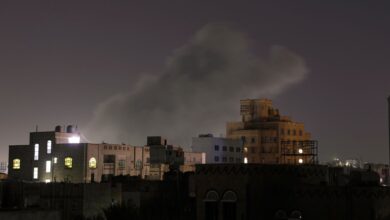‘Padmaavat’ violence: Why Haryana Police fails to maintain law and order – repeatedly

NEW DELHI: Yesterday, a rampaging anti-‘Padmaavat’ mob in Haryana’s Gurugram attacked school buses taking children home.
As the group of 50-odd hooligans hurled bricks, stones and other projectiles on the bus, as many as 30 terrified children huddled under the seats to shield themselves from the missives and from glass shards flying at them as more and more windows shattered. That’s not all. The kids got off easy. Turns out, eyewitnesses said the mob was armed with petrol bombs and tried to set fire to the school bus. The Haryana Police just about managed to stop that from happening.
This isn’t the first time the Haryana Police has fallen woefully short. Here is a list of four other occasions, from recent times, when the state’s constabulary proved it isn’t equal to the task of maintaining law and order in the face of hooliganism:
Gurmeet Ram Rahim Conviction
On August 25, 2017, minutes, or even seconds, after a court ruled self-styled godman Gurmeet Ram Rahim guilty of rape, thousands of his frenzied supporters gathered outside the courtroom in Panchkula erupted in fury. They began pelting stones, setting fire to vehicles and public property and attacking other bystanders and police.
The Ram Rahim verdict was read out at 3 pm on that day. Within an hour and 15 minutes, five people were already dead in the violence. And the rampaging mob had barely begun its destruction. By 7 pm, as many as 29 people were dead and hundreds wounded; the final death toll was 34.
The violence cost Haryana Rs 126,68,71,700.
All of this, despite the Haryana Police and the rest of India being aware for days that thousands of Ram Rahim supporters were making their way to Panchkula for the final hearing on the case. And all of this, despite failing to take precautions to avoid a repeat of similar violence a mere 18 months earlier.
Jat Quota Agitation
In February 2016, 30 people were killed and over 300 injured in a mere three days of violence by members of the Jat community who were and still are demanding quotas in jobs and education. Nine women were raped – many were gangrapes – during this mob violence. Northern Indian states lost a whopping Rs 34,000 crores in stalled businesses and damage to public property.
How could this have happened?
The Haryana government set up a committee, headed by former Uttar Pradesh Director General of Police Prakash Singh, to investigate.
His verdict: A massive failure on the part of Haryana Police and the administration – at the highest echelons. Singh’s 451-page report indicted 90 police and administrative officers for their failure to act in controlling the violence.
“What was lacking was the will to act, the determination to prevent riotous mobs from assembling in the first instance and then dealing with them effectively while they were committing acts of violence, arson, loot or vandalism… officers at the district level, barring a few honourable exceptions, just did not rise to the occasion,” said the report.
The report detailed a litany of acts that amounted to dereliction of duty – cowardice, hesitation in taking swift and decisive action, deliberate avoidance due to a caste bias, and worst of all, abetment, in some instances.
“They were either unequal to the daunting situation they faced or they could not mobilise the full strength of the officers and men under their command, some of whom went missing or deserted their duties,” said the report.
Arrest of Self-Styled Godman Rampal
In November 2014, six people died and more than a 100 were injured in a two-week standoff between Rampal’s supporters and Haryana police in Barwala, Hisar.
Rampal’s supporters refused to allow the police to enter the premises to arrest their godman, against whom the Punjab and Haryana High Court had issued a non-bailable warrant.
Some 15,000 Rampal followers – including women, children and the aged – were being forced to remain inside Rampal’s ashram in Barwala, so they could act as a human shield for the ‘godman’ against the police.
In January 2011, members of 12 Jat community khap panchayats in Haryana blocked rail and road traffic in Jind district for 11 days, to protest the arrest of some from their community in the 2010 Mirchpur caste violence incident. The blockade was accompanied by large-scale vandalism – buses were stoned, rail tracks were damaged and 3,130 trees felled.







